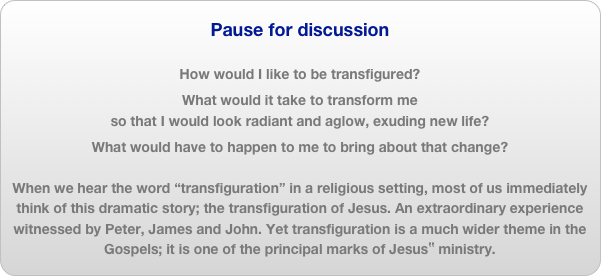
Lenten Studies - Week 3: “On the Mountain”
Reflecting on the Gospel story:
Disfiguration
When we hear the word “transfiguration“ in a religious setting, most of us immediately think of this dramatic story: the transfiguration of Jesus. An extraordinary experience witnessed by Peter, James and John. Yet transfiguration is a much wider theme in the Gospels; it is one of the principal marks of Jesus‟ ministry.
Remember the scene when John the Baptist, confined in prison, sends his own disciples to ask Jesus the question: “Are you the one who is to come, or are we to wait for another?” When John‟s disciples find Jesus, they can see how his work focuses on the disfigured people.
“Jesus had just then cured many people of diseases, plagues, and evil spirits, and had given sight to many who were blind. And he answered them, „Go and tell John what you have seen and heard; the blind receive their sight, the lame walk, the lepers are cleansed, the deaf hear, the dead are raised, the poor have good news brought to them.‟ (Luke 7:21-22)
Jesus‟ ministry is seen in terms of transfiguration; through the power of God at work in him, Jesus rebuilds those who are broken, restores those who are wounded and brings good news to those who are overburdened, so that their best selves are freshly revealed. Jesus is followed by crowds of people desperate for transfiguration—for healing, for forgiveness, for acceptance. We never once see Jesus embarrassed by people, however disfigured or deformed they might be; rather, he seeks them out as the focus of his mission: “Those who are well have no need of a physician, but those who are sick, I have come to call not the righteous but sinners to repentance.” (Luke 5:31-32)
When we think of our own transfiguration we tend to focus on something that is wrong in our lives, some distortion in our personality that could benefit from treatment or some ancient wound that needs healing. If, for instance, you felt hopelessly unappreciated in your life and work, transfiguration for you might be the experience of your family and fellow workers holding you in high regard, thus making you feel worthy and worthwhile. In that new experience of their genuine estimation you would walk differently; you would look at the world anew.
In the parable of the Last Judgement, in Matthew 25, we learn that just as we all have the capacity to disfigure people - by ignoring them-we also have the capacity to transform them-by attending to them. Matthew introduces us to different groups-the hungry, the thirsty, the naked, the estranged, the sick and the imprisoned-a litany of people defined by their hardship or destitution, all longing for others to attend to their plight and transfigure them with mercy and kindness.
And the people who are welcomed into the fullness of the kingdom are not superstars who have performed spiritual heroics, but ordinary folk who have paid attention to the plight of their brothers and sisters. The blessed are commended for their actions, not their attitudes; for what they did, not for what they thought. Misery obliged them to act, so their active verbs prove to be what is important. Their response was humane and, therefore, profoundly religious; it is blessed as the kingdom response of those who take responsibility for a broken world. They inherit a kingdom because they paid attention and transfigured others by their kindness.
Journeying with Jesus
Following the new Companion Guide written for groups: by Father Denis McBride




















Throughout his ministry Jesus is seen to transfigure people, liberating them from a world where their deformity or sin defines who they are. And the day comes when Jesus is transfigured himself by the Father who loves him.
The setting
In Luke‟s Gospel we find narrated a narrative of Jesus‟ public ministry concludes with a strange incident: his own townspeople of Nazareth take Jesus from the local synagogue and then try to kill him by throwing him from a nearby hilltop. That violent rejection on a hilltop in Nazareth is dramatically reversed when Jesus later climbs to the higher hilltop of Tabor and receives the loving acceptance of his Father.
The experience of disfiguration that Jesus undergoes at the hands of his own people can be dramatically juxtaposed with his experience of transfiguration on the mountain: on this summit he hears his name called in life, and that experience of fatherly approval radically changes him. Where Nazareth says no, Tabor says yes; where Nazareth leads Jesus only to run away from the hillside, Tabor leads him to set his face towards an ancient appointment in the city of Jerusalem.
Unsurprisingly, Tabor has been popularly chosen as the traditional place for the transfiguration not least because it is the highest summit in the region, the nearest to the heavens. When you stand on Mount Tabor you can look north-west across the valley and look down on the hills surrounding Nazareth: acceptance dominates rejection; love outflanks violent disapproval.

Two challenges facing Jesus
Before Jesus climbs the mountain, there are two outstanding challenges he has to face.
The first concerns the growing opposition to his mission, led by the religious authorities of his day, the chief priests and scribes, a hostility that seems determined to put him to death. How can Jesus continue in the direction his mission is leading him when the prospect of his early death has shifted from the probable to the inevitable?
The second challenge Jesus faces, following his rejection in Nazareth and discovering how the crowds identify him, is about how he is regarded by people: “Who do people say I am?” If no one knows your true name or recognises your real identity, how can you succeed with your declared mission?
In the first challenge
Jesus has to decide which voice he listens to: the voice outside, coming from the official religious leaders, stating that he is a fake and an agent of the devil, misguiding the people and perverting the tradition of the ancestors; or the voice inside, which directs him in the choices he makes and the people he cherishes. Jesus has to make up his mind whether he is going to listen to his personal inner voice, or the official outer voice. If he continues to follow his inner voice, it will surely lead to death in a most ugly, violent way.
Jesus recognises that the religious authority is desperately determined to maintain stability among the people and oversee teaching while ensuring the tradition remains sacred. Someone who openly criticises religious authority, will clearly pose a threat to the time-honoured conventions of the regular life.
The religious authority decides early on in the ministry of Jesus that, for the sake of the community, Jesus has to die. The high priest Caiaphas will conclude his judgement by stating that, on balance, it is expedient that one person should be dismissed to ensure the peace of the community.
In the second challenge
Focussing on his identity, Jesus will risk the question, before he climbs the mountain, inviting his disciples to report on who people think he is, then challenging them to answer the same question. It is always risky to invite the evaluation of others by asking them who they think you are, not least because the answer you hope to receive is probably not the answer you will hear. Rather than risking the question, “Who do you say I am?” we are more likely to be heard saying, “Who do you think you are?” If no one knows your name or your true identity, then inevitably that experience will hurt you and diminish you.
The report of the disciples—the people perceive Jesus to be John the Baptist or Elijah or one of the prophets-is not an answer calculated to excite. How would you feel if you were told you were an old prophet having another go at things? Do the answers Jesus hears drive Jesus to climb the mountain and commune with God in prayer? However Jesus thought of himself during his ministry, we have no account of that in the Gospels. The Gospel writings reflect the estimation of the Christian community about who they believe Jesus to be at the time of writing: the Gospels reflect the community‟s faith in who Jesus is; they do not report on how Jesus thought of himself during his ministry. Everything they write about Jesus is written through the lens of their faith in Jesus as Lord. Jesus must have had a strong sense of his identity, a sure sense of his own authority and an unwavering understanding of what his mission involved. Insecurity about your identity and direction do not easily graduate into a clear sense of your own authority and a stubborn determination to take a specific road in life However deeply you understand your own identity and direction, it is difficult to hold on to that sense of yourself when it is not recognised or shared by others. We need others to confirm us in who we are; we need other voices to validate our identity. And, for Jesus, that validation is at the heart of the transfiguration account.
The two answers Jesus receives
In the structure of the transfiguration account, there is a simple element and a wonderful element. In the simple element Jesus goes up a mountain, taking with him his three favourite disciples, Peter, James and John. His stated purpose in going up the mountain is not to manifest himself to his disciples but to pray. During his prayer something happens to him; he visibly changes while he prays, becoming radiant and aglow.







Jesus clearly has an answer to his prayer. What was the answer? And what was it, in the first place, that drove him to pray?
Two answers are given: the first about Jesus’ destiny, the second about his identity.
The evangelists are interpreting the prayer experience of Jesus. “Moses and Elijah appear in glory” and they speak not only to Jesus but to us, the listeners and readers—so we attend to what they are saying. They announce something extraordinary: that Jesus‟ departure (exodus) is to be accomplished in Jerusalem. At the heart of this revelation is the truth that Jesus‟ departure, his final departure in death will be the fulfilment of his mission, not its cancellation. His mission and his death are not contradictory forces; rather Jesus’ death will be the accomplishment of his mission.
The evangelists are interpreting the prayer experience of Jesus. “Moses and Elijah appear in glory” and they speak not only to Jesus but to us, the listeners and readers—so we attend to what they are saying, They announce something extraordinary; that Jesus‟ departure [exodus] is to be accomplished in Jerusalem. At the heart of this revelation is the truth that Jesus‟ departure, his final departure in death, will be the fulfilment of his mission, not its cancellation.
His mission and his death are not contradictory forces; rather, Jesus death will be the accomplishment of his mission.
Summary
After questioning his disciples about who people say he is, Jesus takes three disciples up a mountain to pray. During his prayer experience he is visibly changed. He is identified as the favoured Son of God, and hears that his mission will be accomplished in Jerusalem, even though that mission will involve his death.
These two declarations resolves two challenges Jesus faces: first how people identify him and second his mission versus the likelihood of his death.
Jesus comes down the mountain and sets his face resolutely for Jerusalem.


Questions for reflection










Please click here to read a transcription from Luke’s Gospel.
